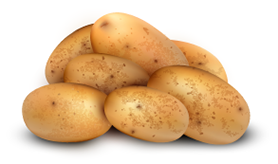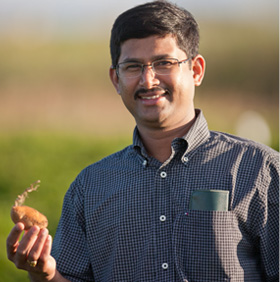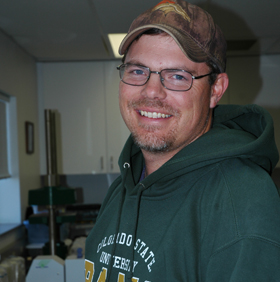Potato Breeding and Selection
Welcome to the Poatao Breeding and Selection Program
Potato Breeding and Selection Home
Current Annual Reports
2023 Colorado Potato Breeding and Selection Report
2022 Potato Breeding and Selection Report
Program Overview
The major objectives of the Colorado Potato Breeding and Selection Program are: (1) to develop new potato cultivars with increased yield, improved quality, improved nutritional and health characteristics, resistance to diseases and pests, and tolerance to environmental stresses; (2) to collaborate with growers, shippers, processors, and research/extension personnel to assess the production, adaptability, marketability, and other characteristics of advanced selections from the Colorado program; (3) to provide a basic seed source of selections to growers for seed increase and commercial testing; (4) to evaluate promising selections for possible export (interstate and international).
The primary emphasis is placed on the development of russet cultivars. The balance of the breeding effort is devoted to developing red, specialty, and chipping cultivars. This broad approach is important because it recognizes the diverse markets accessed by potato growers throughout Colorado.
Besides the major objectives outlined previously, specific breeding emphasis is being placed on identifying germplasm and developing cultivars that have: (1) early vine maturity and early tuber bulking; (2) immunity to PVY; resistance to (3) late blight (foliar and tuber); (4) storage rots [dry rot (Fusarium and early blight) and bacterial soft rot]; (5) pink rot; (6) nematodes; (7) powdery scab; (8) corky ringspot; and (9) that have improved nutritional quality, health attributes, and other “consumer” characteristics such as improved red skin color retention and improved shelf life. Continued emphasis is placed on breeding/selecting for “low input” cultivars, primarily for reduced nitrogen and fungicide input, for improved postharvest and processing qualities such as lengthened dormancy. Cultivars with these characteristics will help assure that the potato industry in Colorado will remain productive and in a competitive position.
Cultivar development is a five-step process, encompassing first, the generation of segregating populations followed by evaluation for visual agronomic traits. This involves identifying parents with desired characteristics for crossing to produce true (botanical) potato seed (TPS). TPS is planted to produce seedling tubers for field planting. Second, superior progeny are identified and these selections undergo additional evaluation for economically important characteristics. Third, a profile of cultivar specific management criteria – production and postharvest – are developed, which a grower, shipper, or processor, and/or marketer may fine tune for his/her operation. Fourth, a basic seed source of selections is developed to facilitate further seed increase and commercial testing of advanced selections. Finally, market development takes place to determine consumer acceptance and recognition in the market for the intended use. Each of these integrated steps is critical in the development and commercialization of new cultivars and provides the base for a successful cultivar release. Without all components, fruition is difficult to attain.
The process of cultivar development takes 14+ years. Years 1 and 2 are the potato breeding phase of the development process. As indicated earlier, parents are selected and crossed to produce true potato seed. Seedling tubers are then produced from the true seed in year 2. Subsequent years (3+) represent the selection phase of the development process. Each year represents another cycle of field selection. As each cycle is completed, fewer and fewer clones remain and the amount of seed per selection is increased. Clones remaining after eight cycles of field selection are released to growers for evaluations prior to official release as a named cultivar. Table 1 presents a generalized description of the steps involved in developing new potato cultivars.
The long-term process of cultivar development fosters collaborations among growers, shippers, processors, researchers, and extension personnel. The network must provide for a grower evaluation process to assist in the development of management guidelines, detect unforeseen problems, and determine the predictability of performance of each new cultivar.






